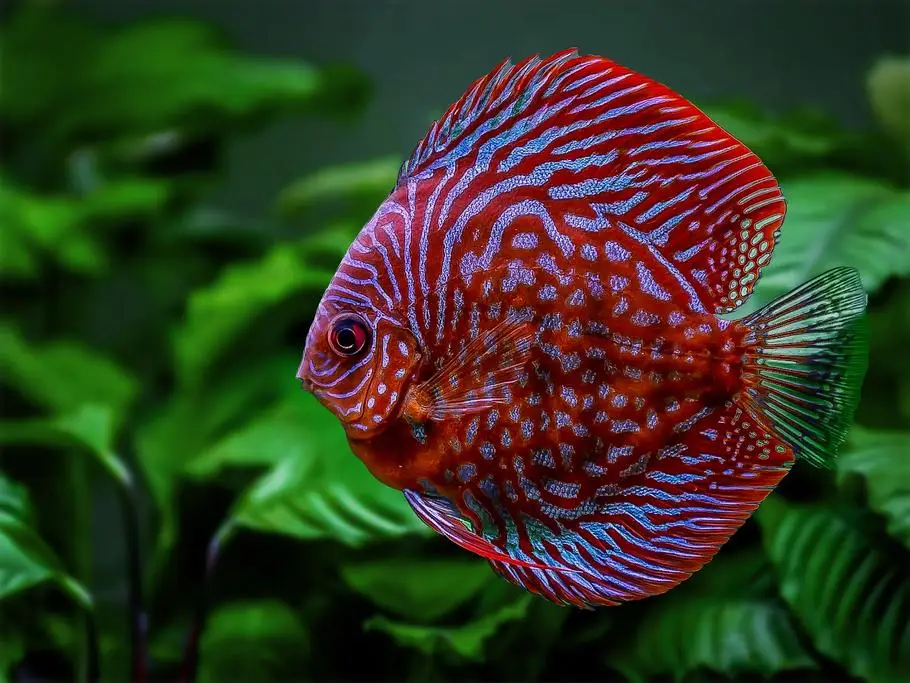Discuss

The Regal Discus: A Comprehensive Guide to Care and Husbandry in the UK
The discus fish (Symphysodon sp.), often hailed as the “King of the Aquarium,” is a majestic and captivating species renowned for its vibrant colours, stately presence, and engaging personality.1 Native to the warm, soft, and acidic waters of the Amazon River basin, these cichlids have enchanted aquarists for decades.2 While their reputation as a challenging species precedes them, successful discus keeping is eminently achievable with the right knowledge and dedication. This in-depth guide will provide you with all the necessary information to create a thriving environment for these stunning fish in the UK.
Understanding the Discus
Discus are laterally compressed, circular-bodied fish that can grow to a significant size, often reaching 6-8 inches (15-20 cm) in diameter.3 They are social creatures and thrive in groups, exhibiting complex hierarchical behaviours.4 Keeping them in shoals of at least five or six individuals is crucial to their well-being, helping to distribute aggression and reduce stress. In a well-maintained aquarium, discus can live for 10-15 years, becoming cherished long-term pets.
Setting Up the Perfect Discus Aquarium
Creating the ideal habitat is the cornerstone of successful discus care. This involves careful consideration of tank size, filtration, heating, and decor.
Tank Size: Due to their adult size and shoaling nature, a spacious aquarium is non-negotiable. For a group of 5-6 adult discus, a minimum tank size of 250 litres (approximately 55 gallons) is recommended. A taller tank is preferable to accommodate their body shape.5
Filtration: Excellent and stable water quality is paramount. Discus are sensitive to nitrogenous waste (ammonia, nitrite, and nitrate).6 A robust filtration system is essential. Canister filters are a popular choice as they offer a large capacity for biological and mechanical media and can be configured to provide gentle flow, which discus prefer.7 Many keepers in the UK opt for two canister filters for redundancy and enhanced filtration.
Heating and Temperature: Discus require significantly warmer water than most tropical fish. Maintaining a stable temperature is critical for their immune system and metabolism.8
| Parameter | Recommended Range |
| Temperature | 28-30°C (82-86°F) |
Use a reliable aquarium heater and a separate thermometer to monitor the temperature accurately. In the UK, where ambient room temperatures can fluctuate, a high-quality heater is a worthwhile investment.
Substrate and Decor: While a bare-bottom tank is easiest for cleaning, a thin layer of fine sand substrate is more natural and allows for foraging behaviour.9 If using substrate, regular and thorough cleaning is vital to prevent the build-up of waste.
Decor should be smooth to prevent injury to the fish’s delicate bodies. Bogwood and smooth rocks can be used to create hiding places and a more naturalistic environment.10 Live plants can be incorporated, but they must be able to tolerate the high temperatures.11 Hardy species like Amazon Swords, Anubias, and Java Fern are suitable choices.12

Water Parameters: The Key to Healthy Discus
Replicating the soft, acidic water of their natural habitat is a primary goal. While many tank-bred discus, particularly those from German breeders, have adapted to harder water, striving for optimal conditions will always yield better results.
| Water Parameter | Ideal Range | Notes for UK Keepers |
| pH | 6.0 – 7.0 | UK tap water is often hard and alkaline. Using Reverse Osmosis (RO) water is highly recommended. |
| General Hardness (GH) | 1 – 8 dGH | RO water will need to be remineralised to achieve a stable GH and prevent pH crashes. |
| Carbonate Hardness (KH) | 1 – 4 dKH | A low KH is desirable, but some is needed to buffer the pH and prevent it from fluctuating wildly. |
| Ammonia | 0 ppm | |
| Nitrite | 0 ppm | |
| Nitrate | < 20 ppm | Regular water changes are essential to keep nitrates low. |
Water Changes: Frequent and substantial water changes are non-negotiable for discus. A weekly water change of 50% is a good starting point. The new water should be dechlorinated and heated to match the tank’s temperature before being added. For those in hard water areas of the UK, mixing tap water with RO water or using solely remineralised RO water is the best approach.
Feeding Your Discus: A Varied and Nutritious Diet
Discus are omnivores and require a high-protein diet.13 A varied feeding regime is essential for their health and vibrant colouration.
| Food Type | Frequency | Examples |
| High-Quality Flake or Granules | Daily | Discus-specific formulas |
| Frozen Foods | Daily | Bloodworm, Brine Shrimp, Mysis Shrimp, Discus mixes (beefheart based) |
| Live Foods | Occasionally | Blackworms, Daphnia (ensure they are from a disease-free source) |
| Freeze-Dried Foods | Occasionally | Tubifex, Krill |
Feed small amounts two to three times a day, only giving what they can consume within a few minutes. Siphon out any uneaten food promptly to maintain water quality.
Choosing Suitable Tank Mates
Selecting the right tank mates is crucial to avoid stress, competition for food, and the introduction of disease.14 Tank mates must be peaceful and able to thrive in the high temperatures and soft water conditions that discus require.
| Compatible Species | Notes |
| Cardinal Tetras | A classic and peaceful shoaling fish. |
| Rummy Nose Tetras | Another excellent shoaling tetra that indicates good water quality with its vibrant red nose. |
| Sterbai Corydoras | A peaceful bottom dweller that can tolerate the higher temperatures. |
| Bristlenose Plecos | A good algae eater that generally remains a manageable size. |
| Ram Cichlids (German Blue or Bolivian) | Peaceful dwarf cichlids that share similar water parameter needs. |
Species to Avoid: Aggressive or boisterous fish such as most other cichlids (including Angelfish in some cases, as they can be more boisterous feeders), fast-moving fish that may outcompete discus for food, and any fish that cannot tolerate the high temperatures.
Common Discus Health Issues
Vigilance is key to spotting and treating any health problems early. Most issues are related to stress and poor water quality.
| Disease | Symptoms | Common Treatment |
| Ich (White Spot Disease) | Small white spots on the body and fins, flicking against objects. | Increase temperature to 30-32°C (86-90°F) and use a proprietary white spot treatment. |
| Hole in the Head (HITH) | Small pits or holes appearing on the head and lateral line. | Often linked to poor water quality and nutritional deficiencies. Improve diet and water change schedule. Metronidazole is a common medication. |
| Fin Rot | Frayed or deteriorating fins. | Usually caused by bacterial infections secondary to poor water quality. Improve water conditions and use a broad-spectrum antibacterial treatment. |
| Internal Parasites | White, stringy faeces, loss of appetite, becoming thin. | Medicated foods containing Metronidazole or Praziquantel are often effective. |
Quarantine: It is imperative to quarantine any new fish for at least 4-6 weeks in a separate tank before introducing them to your main discus aquarium. This will help to prevent the introduction of diseases.
The Rewarding Challenge

While the care requirements for discus are more demanding than for many other aquarium fish, the rewards are immense.15 A well-cared-for shoal of discus is a truly breath taking sight, their graceful movements and stunning colours bringing a touch of the Amazon to the home aquarium. By providing a stable, clean, and warm environment, a nutritious diet, and a peaceful community, aquarists in the UK can enjoy the unparalleled beauty of the “King of the Aquarium” for many years to come.


